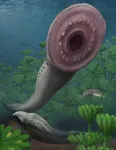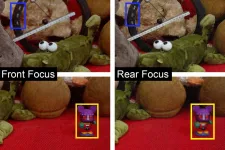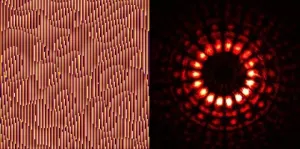(Press-News.org) Ottawa, March 10, 2021 - A new study of fossilized lampreys dating from more than 300 million years ago is challenging a long-held theory about the evolutionary origin of vertebrates (all animals with a backbone). The findings are published March 10 in the science journal Nature.
Lampreys are ancient, jawless, eel-like fishes that arose around half a billion years ago and they have long provided insights into vertebrate evolution. Now, scientists with the Canadian Museum of Nature, the University of Chicago and the Albany Museum in South Africa are reporting their analysis of dozens of tiny fossils that track the life stages and growth of ancient lampreys, from hatchlings to juveniles to adults.
Their results counter the established view that the blind, filter-feeding larvae of modern lampreys (called ammocoetes) are a holdover from the ancestors of all living vertebrates. The new fossil discoveries show that ancient lamprey hatchlings were completely unlike their modern larvae counterparts.
"We've basically removed lampreys from the position of the ancestral condition of vertebrates," explains lead author Tetsuto Miyashita, Ph.D, a palaeontologist with the Canadian Museum of Nature. "So now we need an alternative."
Miyashita explains that lampreys have a curious life cycle. "Once hatched, the larvae of modern lampreys bury themselves in a riverbed and filter feed before eventually metamorphosing into blood-sucking adults. The larvae are so different from adults that scientists originally thought they were different species. Even after finding out they are just an early phase in the lamprey life cycle, scientists saw the image of our distant ancestors in these seemingly primitive larvae."
The newly discovered lamprey fossils are now changing this story. The fossils, belonging to four extinct species, were discovered in South Africa and the United States (Illinois and Montana) and range in age from 310 to 360 million years old. The researchers found that the smallest individuals, barely 15mm in length (fingernail sized), still carried a yolk sac, signalling that these had only just hatched before dying. Further examination revealed that these youngsters already had large eyes and were armed with a toothed sucker, characteristics that in modern lamprey species only develop in the adults.
"Remarkably, we've got enough specimens to reconstruct a trajectory from hatchling to adult in several independent lineages of early lampreys," said Michael Coates, Ph.D, a biology professor at UChicago and co-author of the study along with Rob Gess, Ph.D at the Albany Museum and Kristen Tietjin at the University of Kansas. "They each show the same pattern: the larval form was like a miniature adult."
The researchers say that these results run counter to the 150-year-old evolutionary narrative that modern lamprey larvae, with their curious life cycle, offer a glimpse of deep ancestral vertebrate conditions. By demonstrating that ancient lampreys never went through the same blind, filter-feeding stage seen in modern species, the researchers have falsified the conventional ancestral model shared in textbooks.
After their examination of the fossil record, the researchers now believe that extinct armored fishes known as ostracoderms might instead represent better candidates for the root of the vertebrate family tree, whereas modern lamprey larvae are a more recent evolutionary innovation.
If so, then why do modern lamprey larvae appear so primordial? The team suggests that the evolution of filter-feeding larvae may have been an innovation that allowed lampreys to populate rivers and lakes. Fossil lampreys reported in the new study all came from marine sediments, but modern lampreys, with their filter-feeding, blind larvae, mostly live in freshwater.
For ancient blood-sucking lampreys, rivers and lakes would be tough environments in which to migrate because of the limited and unpredictable supply of prey. "Lampreys solved this problem by burrowing in sand and slurping up whatever food particles were available until they could mature enough to start looking for prey with blood," said Miyashita. "But you don't have to be too complicated for this kind of lifestyle. So even though lampreys invented this filter feeding larval phase anew, the larvae themselves looked simple and primordial. Until now we were misinterpreting this simplicity for primitiveness."
The researchers say that this is the sort of discovery that can rewrite textbooks. "Lampreys are not quite the swimming time capsules that we once thought they were," said Coates. "They remain important and essential for understanding the deep history of vertebrate diversity, but we also need to recognize that they, too, have evolved and specialized in their own right."
Supplemental Information:
The painstaking fieldwork of researcher Rob Gess has been critical to this study, ""Non-ammocoete larvae of Palaeozoic stem lampreys". He has led remarkable excavations of a Late Devonian shale locality near Makhanda, South Africa. In 2006, Gess and Coates described the oldest-known fossil record of an adult lamprey (Priscomyzon riniensis) from the site. Miyashita picked up the collaboration in 2016 and worked on this as a post-doctoral fellow at UChicago. The team also credits the work of Kristen Tietjen, who did the CT scans and life reconstruction of the fossil lampreys.
INFORMATION:
Media contact:
Dan Smythe
Head, Media Relations
Canadian Museum of Nature
613-698-9253 (cell)
dsmythe@nature.ca
A new study out of the University of Chicago, the Canadian Museum of Nature and the Albany Museum challenges a long-held hypothesis that the blind, filter-feeding larvae of modern lampreys are a holdover from the distant past, resembling the ancestors of all living vertebrates, including ourselves. The new fossil discoveries indicate that ancient lamprey hatchlings more closely resembled modern adult lampreys, and were completely unlike their modern larvae counterparts. The results were published on March 10 in Nature.
Lampreys -- unusual jawless, eel-like, creatures -- have long provided insights ...
Despite years of hype, virtual reality headsets have yet to topple TV or computer screens as the go-to devices for video viewing. One reason: VR can make users feel sick. Nausea and eye strain can result because VR creates an illusion of 3D viewing although the user is in fact staring at a fixed-distance 2D display. The solution for better 3D visualization could lie in a 60-year-old technology remade for the digital world: holograms.
Holograms deliver an exceptional representation of 3D world around us. Plus, they're beautiful. (Go ahead -- check out the holographic dove on your Visa card.) Holograms offer a shifting perspective based on the viewer's position, and they allow the eye to adjust focal depth to alternately focus on foreground and background.
Researchers have long sought ...
On December 6, 2016, a high-energy particle called an electron antineutrino hurtled to Earth from outer space at close to the speed of light carrying 6.3 petaelectronvolts (PeV) of energy. Deep inside the ice sheet at the South Pole, it smashed into an electron and produced a particle that quickly decayed into a shower of secondary particles. The interaction was captured by a massive telescope buried in the Antarctic glacier, the IceCube Neutrino Observatory.
IceCube had seen a Glashow resonance event, a phenomenon predicted by Nobel laureate physicist ...
Researchers have struck quantum gold--and created a new word--by enlisting machine learning to efficiently navigate a 20-dimensional quantum treasure map.
Physicist Dr Markus Rambach from the ARC Centre of Excellence for Engineered Quantum Systems (EQUS) at The University of Queensland said the team was able to find unknown quantum states more quickly and accurately, using a technique called self-guided tomography.
The team also introduced the 'quvigint', which is like a qubit (the quantum version of a classical bit that takes on the values '0' or '1') except that it takes on not two, but 20 possible values.
Dr ...
What The Study Did: In this study, most risk factors associated with SARS-CoV-2 infection among health care workers were outside the workplace.
Authors: Jesse T. Jacob, M.D., of Emory University in Atlanta, is the corresponding author.
To access the embargoed study: Visit our For The Media website at this link https://media.jamanetwork.com/
(doi:10.1001/jamanetworkopen.2021.1283)
Editor's Note: The article includes conflict of interest and funding/support disclosures. Please see the article for additional information, including other authors, author contributions and affiliations, conflict of interest and financial disclosures, and funding and support.
INFORMATION:
Media ...
MADISON - On December 6, 2016, a high-energy particle hurtled to Earth from outer space at close to the speed of light. The particle, an electron antineutrino, smashed into an electron deep inside the ice sheet at the South Pole. This collision produced a particle that quickly decayed into a shower of secondary particles, triggering the sensors of the IceCube Neutrino Observatory, a massive telescope buried in the Antarctic glacier.
IceCube had seen a Glashow resonance event, a phenomenon predicted by Nobel laureate physicist Sheldon Glashow in 1960. With this detection, scientists provided another confirmation of the Standard Model of particle physics. It ...
What The Study Did: This study of orthodox Jewisha dults across the United States found that socioculturally bound communities experienced early parallel outbreaks in discrete locations, notably prior to substantive medical and governmental directives.
Authors: Jonathan I. Silverberg, M.D., Ph.D., M.P.H., of George Washington University in Washington, D.C., and Avi Z. Rosenberg, M.D., Ph.D., of Johns Hopkins University in Baltimore, are the corresponding authors.
To access the embargoed study: Visit our For The Media website at this link https://media.jamanetwork.com/
(doi:10.1001/jamanetworkopen.2021.2816)
Editor's Note: The article includes conflict of interest and funding/support disclosures. ...
What The Study Did: In a study of Italian close contacts of patients with confirmed SARS-CoV-2 infection, most infected contacts (1,948 of 2,824 individuals or 69%) didn't develop respiratory symptoms or fever 37.5 degrees Celsius (99.5 degrees Fahrenheit) or higher; 26.1% of infected individuals younger than 60 developed respiratory symptoms or fever 37.5 degrees Celsius (99.5 degrees Fahrenheit); and 6.6% of infected participants age 60 or older developed critical disease.
Authors: Piero Poletti, Ph.D., of Fondazione Bruno Kessler in Trento, ...
What The Study Did: Boston experienced a COVID-19 surge that disproportionately affected persons experiencing homelessness and a large safety-net hospital implemented a novel COVID-19 recuperation unit for these patients that provided isolation, quarantine and treatment for substance use. Researchers aimed to determine the association of the care provided by the unit with COVID-19 hospitalizations among people experiencing homelessness.
Authors: Joshua A. Barocas, M.D., of Boston Medical Center, is the corresponding author.
To ...
What The Study Did: Findings of this study suggest that patients recovering from COVID-19-associated acute kidney injury require monitoring of kidney function following hospital discharge.
Authors: F. Perry Wilson, M.D. M.S.C.E., of the Yale University School of Medicine in New Haven, Connecticut, is the corresponding author.
To access the embargoed study: Visit our For The Media website at this link https://media.jamanetwork.com/
(doi:10.1001/jamanetworkopen.2021.1095)
Editor's Note: The article includes conflict of interest and funding/support disclosures. Please see the article for additional information, including other authors, author ...



